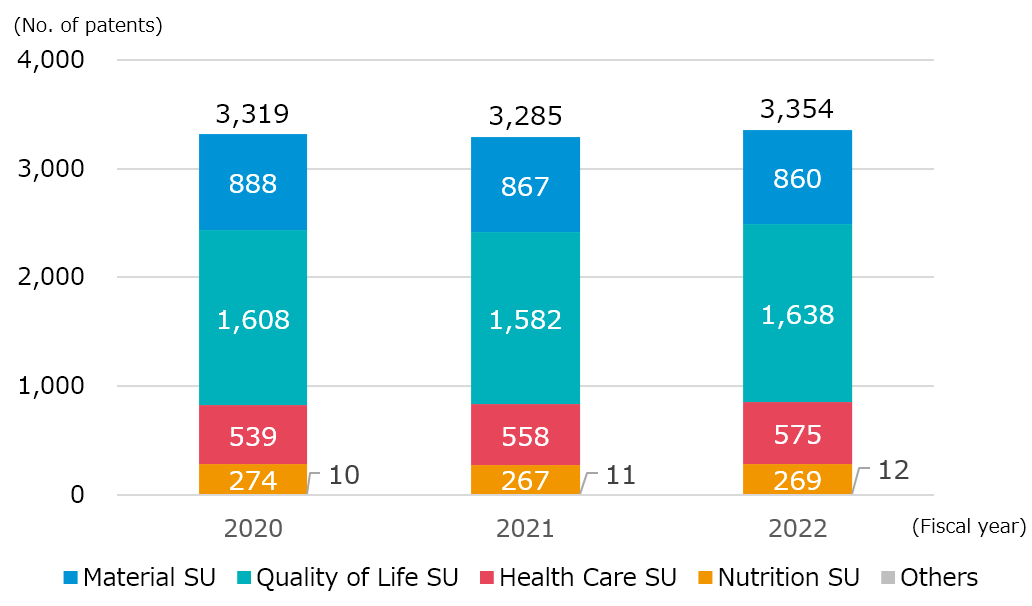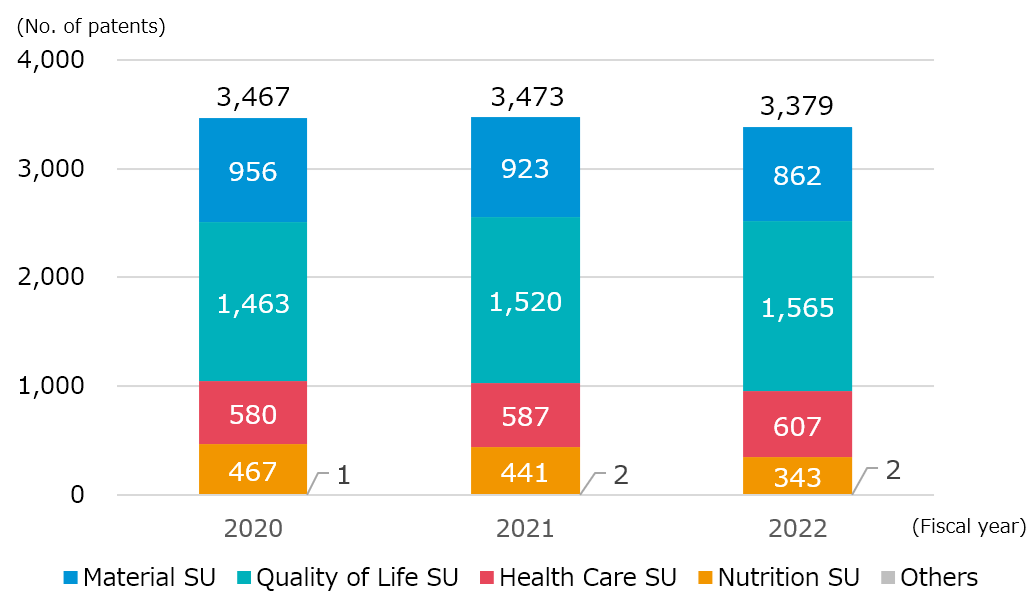Intellectual Property
Basic Policy
Kaneka Group secures intellectual property rights, such as patents for our R2B+P results, aiming to provide prompt solutions to help resolve social issues. All our researchers and engineers recognize intellectual property as one of the outputs of R2B+P activities and actively seek to acquire intellectual property rights for their achievements including know-how.
To respect the intellectual property rights of others and avoid patent disputes, we make sure to carry out patent searches, trademark searches, and design surveys at various stages in the business development process, such as theme proposals, capital investments, commercialization, specification changes, and brand naming, taking every possible precaution to ensure clearance.
Promotion System
The Intellectual Property Department, which operates directly under the President, works to secure and maintain the Kaneka Group’s intellectual property, which supports our business.
At each of our regional headquarters in the Americas, Europe, and Asia, we have put a framework in place for assigning intellectual property specialists to respond directly to local issues. To mitigate intellectual property risks and prevent leaks of trade secrets at Group companies in Japan and overseas, we are also shoring up cooperation between the various Group companies and the Intellectual Property Department.
Based on our Corporate Governance Code, which we revised in 2021, we continue taking actions to improve our governance of intellectual property. The director in charge of the Intellectual Property Department receives reports and gives directions at monthly reporting meetings.
In addition, in line with our intellectual property strategies, meetings are held once a year for each division. These meetings are attended by general managers of the division, the research division, and the Intellectual Property Department. We will continue to strengthen the linkage between our intellectual property strategy and the business and research strategies of each division, with the aim of contributing to business performance.
Creation of Intellectual Property
To strengthen the business portfolio, Kaneka proactively files patent applications in Japan and overseas and works to acquire rights.
In fiscal 2023, we filed 316 new patents in Japan and 239 patents overseas. At the same time, we are working to efficiently manage the costs of intellectual property. As a result of actively surrendering dormant patents, we held 3,426 patents in Japan and 3,305 patents overseas as of the end of fiscal 2023, roughly the same number as the previous year. We will continue our efforts to build an even robust intellectual property portfolio.
Number of Japanese Patents Held

Number of Overseas Patents Held

Resources and Intellectual Property

Intellectual Property Activities
We focus on educating our researchers and engineers about intellectual property. This ensures that they understand the importance of intellectual property as one of the outputs of our R2B+P activities, so that they will seek to acquire rights for their achievements and actively utilize them.
Employees in charge of technology and sales, including those at Group companies, undergo the training. We prepare content on a range of topics from the basics of intellectual property to applications such as discovery of inventions and preparation of statements, and even intellectual property strategies. The materials are tailored for each organizational level, from new hires and junior employees to mid-level employees and those in leader positions. For our intellectual property education, we have prepared a wide range of programs. These programs, which include e-learning, cover areas such as search training, licensing stage training, strategic initiatives such as training on theme creation and market data utilization, and training on trademark, brands, and copyrights. We also work with external experts to develop our human resources in areas such as theme creation, data utilization, and strategy planning.

Intellectual Property that Leads to Value Creation
In fiscal 2023, we focused on filing patents and securing rights for technologies that address three major challenges—environment/energy, food, and wellness—to help tackle pressing social issues.
For environment/energy, Kaneka has focused on KANEKA Biodegradable Polymer Green Planet™.
To broaden the uses of Green Planet™, we have developed processing technologies suited for food packaging and straws, and have secured patent rights not only in Japan but also in Europe, China, and other markets. In addition to patents, we have obtained design rights for items such as cutlery and hairbrushes, protecting the value of our technologies and products through a range of intellectual property. By starting with materials that break down in the ocean, we aim to create new value in the environmental and energy fields.
In food, we have secured rights for a manufacturing technology that brings out the flavor of foods and beverages while delivering a clean, refreshing aftertaste in dairy drinks. These technologies, which adjust the taste and composition of milk to suit different foods and drinks, are used in Hokkaido raw milk products such as Milk for Bread™. We have also filed trademark applications as part of efforts to strengthen our intellectual property around organic dairy products made from organic A2 milk, produced through circular organic dairy farming in partnership with dairy companies. We will continue to deliver new food value that supports both health and great taste.
In wellness, we are broadening the use of reduced coenzyme Q10 to offer more value to customers. Beyond conventional capsules, we have filed and secured rights for technologies covering tablets, yogurt, gummies, and other forms. To refresh our intellectual property portfolio for reduced coenzyme Q10, we are driving new technology development and IP strategies. By securing rights for new technologies, we are building new barriers to entry and safeguarding our market edge for the long term.
Through these technologies, we will help create patent value that addresses social issues.
Data Utilization
Data Utilization Initiatives
To boost the competitive strength of our business, we are promoting information analysis and information utilization initiatives such as IP landscape™. Following on from the deployment in fiscal 2021 of specialized personnel, in fiscal 2022, we strengthened our efforts by establishing a new group within the Intellectual Property Department that specializes in analyzing and using information.
In fiscal 2023, we drove innovation across the organization by hosting seminars and workshops on how to use information effectively to spark new business ideas. While sharing the importance and usefulness of data utilization by the Intellectual Property Department and business divisions, this group enables coordination aimed at developing strategies for a range of research and development and business issues. By understanding customer value and analyzing the competitive environment, we aim to improve our business competitiveness.
IP landscape™ is a registered trademark of Masayuki Shobayashi, patent attorney at Shobayashi International Patent & Trademark Office.
Using Patent Scores
We use a wide range of patent analysis tools to review our patent portfolio, referencing the value of our published patents. In our portfolio review, we focus on the value of each patient, conducting an inventory check of the rights we hold. In determining whether we need to maintain the rights to registered patents, we tap into the insights of the Company’s technology and business leaders, assess the cost of maintenance, and check the objective patent score.
Protecting our Technology and Brands
Information Leakage and Legal Compliance
To prevent our proprietary technology and know-how from being leaked, we provide intellectual property protection training to sales representatives. The training, which includes measures against leakage of confidential information, is provided when these staff are developing customers or providing samples. We also regularly provide training to instill respect for the rights of others and strengthen compliance with laws and regulations on copyright, covering topics such as preventing copyright infringement when creating materials.
Protecting our Brands
To support the brand development of our mainstay products, we have acquired trademarks in countries around the world to protect the brands of global products such as KANEKA Biodegradable Polymer Green Planet™ and KANEKALON™ hair accessory products. We constantly monitor trademark applications around the world, working continuously to prevent others from licensing the same or similar trademarks. If an application for a similar trademark is detected, an objection is filed with each country’s patent office, which leads to others being prevented from licensing similar trademarks.
To ensure that our trademarks are correctly used and applied in our business, we held trademark seminars in fiscal 2023 for business divisions that hold a large number of trademarks.
